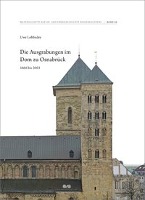Die Ausgrabungen im Dom zu Osnabrück
BücherAngebote / Angebote:
Der Osnabrücker Dom St. Petrus war die Keimzelle der Stadt und der letzte noch unerforschte sächsische Dom der Zeit Karls des Großen. Diese Lücke schließt der vorliegende Band, der die Befunde der 6 Bauphasen, die Bischofsgräber und die bemalten Wandputzfragmente präsentiert. Die Forschungen im Domumfeld folgen in einer zweiten Publikation. Bau I war ein ca. 10 x 20 m großer Apsidensaal, wohl über der Steinkirche einer Missionszelle des 8. Jhs, älteren Siedlungsresten und Gräbern mit Baumsärgen errichtet, der als Bischofskirche des 795-805 gegründeten Bistums diente. Bau II war eine sehr große Querhausbasilika mit Chorjoch, Apsis und zwei Türmen mit direkten Bezügen zu Reichenau und St. Gallen aus der Zeit vor 833. Bau III des 9./10. Jhs umfaßt Neubauten von Querhaus, Chorjoch und Apsis sowie einen Kryptenstollen. Periode IV bezeichnet die Erneuerung von Vierung und Chorjoch im späten 11. Jh., Bau V das romanische Westjoch der Zeit vor 1100. Phase VI brachte den 1227-1239 geweihten spätromanischen Dom hervor. Die Befunde zeigen, daß Osnabrück der Drehpunk und Angelpunkt für die norddeutsche Mission war und nicht Minden, wie früher angenommen.
The Cathedral of Saint Peter at Osnabrück was the germ of the town and the last Saxon Cathedral of Charlemagne's times uninvestigated yet. This gap is now closed by this volume with the features of 6 construction phases, the bishops' graves, and the fragments of mural paintings. The evidence from the surroundings will be published separately. Church I was an apsidal hall of some 10 x 20 m probably built over the stone church of an 8th-century missionary cell, earlier settlements and burials with tree trunk coffins. It served as the episcopal church of the diocese founded in 795 to 805. Church II was a large basilica of the period before 833 with a transept, chancel, apse, two towers, and immediate parallels in Reichenau and St. Gallen. Building III of the 9th/10th century comprised a new transept, chancel, and apse as well as a crypt gallery. Period IV describes the rebuilding of the intersection and the chancel in the late 11th century, church V the Romanesque west bay prior to A.D. 1100. Phase VI produced the late Romanesque cathedral consecrated in 1227 to 1239. The evidence attests that the pivotal point for the mission of North Germany was Osnabrück, not Minden as had been assumed before.
Folgt in ca. 2-3 Arbeitstagen




